
Journal of Modern Dynamics
Scope & Guideline
Advancing the Frontiers of Mathematical Inquiry.
Introduction
Aims and Scopes
- Dynamical Systems Theory:
The journal emphasizes the study of dynamical systems, exploring their behaviors, properties, and classifications through various mathematical techniques. - Hyperbolic Geometry and Dynamics:
Papers often delve into hyperbolic spaces and their dynamical properties, contributing to the understanding of flows and group actions in these geometries. - Ergodic Theory:
A significant focus is placed on ergodic theory, examining the statistical properties of dynamical systems and their long-term behavior. - Geometric Dynamics:
Research on the interplay between geometry and dynamics is prevalent, particularly in how geometric structures influence dynamical behaviors. - Rigidity and Classification:
The journal includes studies on rigidity phenomena in dynamical systems, classifying actions and understanding their invariants. - Applications of Dynamics:
Applications of dynamical systems in various mathematical contexts, such as number theory and statistical mechanics, are also a core focus.
Trending and Emerging
- Nonlinear Dynamics and Chaos:
There is a noticeable increase in research related to nonlinear dynamics and chaotic systems, reflecting a growing interest in complex behaviors that arise in various mathematical and applied contexts. - Higher-Dimensional Dynamics:
Emerging studies are focusing on dynamics in higher-dimensional spaces, expanding the traditional boundaries of dynamical systems research. - Connections Between Dynamical Systems and Other Mathematical Fields:
An increasing trend is observed in interdisciplinary research that connects dynamical systems with areas such as algebra, topology, and mathematical physics, highlighting the integrative nature of modern mathematical inquiry. - Stochastic and Random Dynamical Systems:
Research on stochastic processes and their dynamical systems applications is gaining traction, indicating a shift towards understanding randomness within dynamical contexts. - Computational Dynamics:
There is a growing emphasis on computational methods in studying dynamical systems, reflecting advancements in technology and the need for numerical approaches in complex systems analysis.
Declining or Waning
- Classical Mechanics Applications:
There appears to be a waning interest in topics directly related to classical mechanics within dynamical systems, which may reflect a broader trend towards more abstract or generalized theories. - Low-Dimensional Topology:
Research that intersects with low-dimensional topology has diminished, potentially indicating a shift towards higher-dimensional dynamics or other areas of mathematics. - Historical Perspectives in Dynamics:
Papers focused on historical perspectives or foundational aspects of dynamical systems are less frequent, suggesting a move away from retrospective analyses towards contemporary applications and theoretical advancements.
Similar Journals

Mediterranean Journal of Mathematics
Elevating Research Standards in the Heart of the MediterraneanThe Mediterranean Journal of Mathematics, published by SPRINGER BASEL AG, is a prominent platform dedicated to the advancement of mathematical research and education. Since its inception in 2004, this journal has been pivotal in disseminating high-quality research across various fields of mathematics, currently holding a notable Q2 ranking in the miscellaneous mathematics category as of 2023. With its ISSN 1660-5446 and E-ISSN 1660-5454, the journal enjoys a respected position in the academic community, evident by its Scopus rank of 129 out of 399 in General Mathematics, placing it in the 67th percentile. While primarily a subscription-based journal, it remains committed to providing a comprehensive resource for researchers, professionals, and students, fostering dialogue and exploration within the mathematical sciences. The Mediterranean Journal of Mathematics, based in Basel, Switzerland, continues to contribute significantly to the evolution of mathematical theory and practice, marking its relevance as we approach its 20th anniversary in 2024.
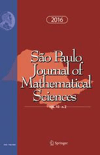
Sao Paulo Journal of Mathematical Sciences
Cultivating a vibrant community of mathematical thinkers.Welcome to the Sao Paulo Journal of Mathematical Sciences, a pivotal platform dedicated to advancing the field of mathematics, published by Springer International Publishing AG. Established in 2015 and running until 2024, this journal serves as a vital resource for researchers, professionals, and students interested in a plethora of mathematical topics, including computational theory, statistics, and general mathematics. While the journal holds a current Q4 quartile ranking in its categories, it provides an opportunity for contributors to disseminate innovative findings in an accessible manner. Although not an open-access publication, the journal is committed to ensuring that high-quality research is available to the academic community, fostering collaboration and growth within the discipline. Researchers seeking to publish in a dynamic and developing journal should consider the Sao Paulo Journal of Mathematical Sciences as an essential avenue for their work.

Revista Matematica Complutense
Championing High-Impact Research in MathematicsRevista Matematica Complutense is a prestigious peer-reviewed journal published by SPRINGER-VERLAG ITALIA SRL, specializing in the field of mathematics. With its ISSN 1139-1138 and E-ISSN 1988-2807, the journal plays a vital role in disseminating high-quality research and fostering academic discussion within the mathematics community. Recognized for its rigorous selection process, the journal has achieved impressive rankings, holding a Q1 quartile status in the miscellaneous mathematics category as of 2023 and ranking #94 out of 399 in general mathematics according to Scopus, placing it within the 76th percentile. With a publication timeline spanning from 2008 to 2024, the Revista Matematica Complutense continues to serve as an essential resource for researchers, professionals, and students alike. Although it does not currently offer open access, the journal remains committed to advancing mathematical knowledge and providing a platform for innovative research across various mathematical disciplines.
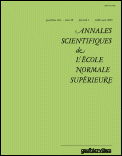
ANNALES SCIENTIFIQUES DE L ECOLE NORMALE SUPERIEURE
Discover Innovative Insights in MathematicsANNALES SCIENTIFIQUES DE L ECOLE NORMALE SUPERIEURE is a distinguished journal published by the Société Mathématique de France, dedicated to advancing the field of mathematics through high-quality research articles. With a robust impact factor and categorized as Q1 in Mathematics (Miscellaneous) as of 2023, this journal ranks in the top 16% of mathematics publications, showcasing its importance and influence in the discipline. Available in both print (ISSN: 0012-9593) and electronic formats (E-ISSN: 1873-2151), ANNALES SCIENTIFIQUES serves as a central hub for innovative mathematical theories and methodologies, appealing to a diverse audience of researchers, professionals, and students alike. The journal publishes research that spans various domains within mathematics, fostering a collaborative environment for idea exchange. As it converges from 1997 to 2024, it continues to shape the mathematical landscape, providing essential insights and developments within the global academic community. Located in Paris, France, the journal invites contributions that push boundaries and advance the understanding of complex mathematical concepts.

Groups Geometry and Dynamics
Unlocking New Dimensions in Mathematical DiscourseGroups Geometry and Dynamics is a pioneering open-access journal published by the European Mathematical Society (EMS), dedicated to advancing the fields of discrete mathematics, combinatorics, geometry, and topology. With its ISSN 1661-7207 and E-ISSN 1661-7215, this journal serves the global mathematical community by providing a platform for high-quality research and insightful discussions. Established in 2009 and showcasing innovative findings through to its converged years of 2024, it has achieved notable rankings, securing a Q1 category in Discrete Mathematics and Combinatorics and a Q2 in Geometry and Topology, indicating its substantial impact within these domains. The journal's presence in Scopus ranks underscores its significance, positioned within the top echelons of its categories. As an open-access publication since 2021, it enhances accessibility and visibility for researchers, professionals, and students alike. Located in Berlin, Germany, and backed by a commitment to fostering collaborative research, Groups Geometry and Dynamics aims to be a leading voice in the mathematical discourse, challenging and inspiring inquisitive minds in the ever-evolving world of mathematics.
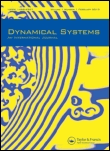
DYNAMICAL SYSTEMS-AN INTERNATIONAL JOURNAL
Fostering Interdisciplinary Insights in Mathematics and ComputingDynamical Systems - An International Journal, published by Taylor & Francis Ltd, serves as a vital resource in the fields of mathematics and computer science applications. With an ISSN of 1468-9367 and E-ISSN 1468-9375, this journal has established a significant presence since its inception in 1996 and continues to contribute valuable insights through 2024. Although it holds a Q3 ranking in both Computer Science Applications and Mathematics (miscellaneous), it is a platform for disseminating innovative research and applications relating to dynamical systems analysis and theory. Despite recent challenges reflected in its Scopus rankings, with percentiles at the 30th and 10th for general mathematics and computer science applications respectively, the journal remains committed to fostering interdisciplinary perspectives and providing a forum for the exchange of ideas among academics, professionals, and students. Open access options ensure that research findings reach a broader audience, enhancing the journal's impact and relevance in a rapidly evolving field.
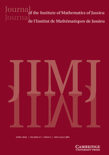
Journal of the Institute of Mathematics of Jussieu
Exploring Innovative Ideas in Mathematical SciencesJournal of the Institute of Mathematics of Jussieu, published by Cambridge University Press, is a leading academic journal that has established itself as a vital resource in the field of mathematics. With an impressive impact factor and a ranking in the top quartile (Q1) of miscellaneous mathematics, the journal serves as a platform for high-quality research from both established scholars and emerging researchers. Spanning from 2002 to 2024, the journal aims to foster collaboration and innovation in the mathematical community by publishing original research articles, reviews, and critical discussions on a wide range of mathematical topics. Although the journal does not offer open access, it remains widely accessible through various academic institutions and libraries, ensuring that critical advancements in mathematics are shared with a global audience. Located in the United Kingdom at the prestigious Cambridge campus, the journal reflects the rigorous standards of its publisher and the rich academic tradition of its home institution.

CUBO-A Mathematical Journal
Fostering Innovation in Mathematical ResearchCUBO-A Mathematical Journal, published by the Department of Mathematics and Statistics at Universidad de La Frontera in Chile, stands as a significant Open Access resource in the field of mathematics since its inception in 2011. With an ISSN of 0716-7776 and an E-ISSN of 0719-0646, this journal invites submissions that explore a wide spectrum of mathematical disciplines, including Algebra, Number Theory, Analysis, Geometry, Topology, and Logic. Although currently positioned in the Q4 category across various mathematical domains and registered at Rank #223/399 in General Mathematics in Scopus, CUBO serves as a valuable platform for emerging researchers and practitioners to disseminate their findings. Operating under a continuous commitment to accessibility, CUBO fosters an inclusive academic environment that supports the exchange of innovative ideas vital to advancing mathematics. The journal's target audience encompasses a diverse community of researchers, professionals, and students eager to participate in the expanding dialogue within mathematical sciences.
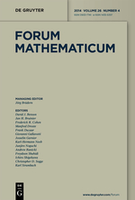
FORUM MATHEMATICUM
Advancing Mathematical Frontiers with Insightful ResearchFORUM MATHEMATICUM, published by WALTER DE GRUYTER GMBH, is a distinguished academic journal based in Germany, known for its significant contributions to the field of mathematics. With an ISSN of 0933-7741 and an E-ISSN of 1435-5337, the journal features comprehensive studies ranging from applied mathematics to diverse mathematical disciplines. Having maintained a commendable presence since 1989, FORUM MATHEMATICUM has achieved notable classification rankings, including Q2 in Applied Mathematics and Q1 in miscellaneous Mathematics as of 2023. Additionally, it holds a Scopus rank within the top 60th percentile in General Mathematics, making it a prominent platform for researchers and professionals seeking rigorous analysis and innovative methodologies in mathematics. While the journal does not currently offer open access, its rich content is pivotal for advancing mathematical theory and applications, appealing to students and seasoned academics alike.
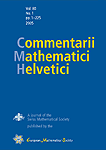
COMMENTARII MATHEMATICI HELVETICI
Pioneering Research in the Heart of MathematicsCOMMENTARII MATHEMATICI HELVETICI, published by the EUROPEAN MATHEMATICAL SOCIETY, is a premier open-access journal in the field of mathematics, specifically categorized within the Q1 quartile of miscellaneous mathematics as of 2023. With an ISSN of 0010-2571 and an E-ISSN of 1420-8946, this esteemed journal has a rich history, having commenced its publication journey in 1929 and set to continue until at least 2024. Based in Germany, it provides a valuable platform for original research and significant advancement in mathematical theory and application, appealing to researchers, professionals, and students alike. The journal's commitment to open access since 2022 further enhances its accessibility and outreach, ensuring that cutting-edge mathematical developments are readily available to a global audience. Its Scopus ranking, which places it at the 165th position out of 399 in the general mathematics category (58th percentile), exemplifies its impact and relevance in the academic community.